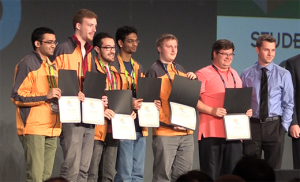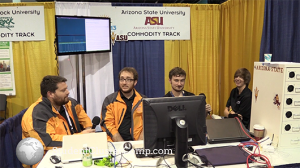Bentley/NEU Rides $2,500 box to glory; ASU grabs second place
The team from Bentley University and Northeastern University took the first-ever Commodity Track Overall Championship award at the recently concluded SC13 Student Cluster Competition. Student teams had to build a true HPC cluster (at least two nodes) while spending a maximum of $2,500.
After building and carting their boxes to Denver, it was time crank ‘em up and see who built the fastest cluster. They had to run the same benchmarks and apps as the Big Iron Standard Track competitors including HPCC, NEMO5, WRF, GraphLab, and the mystery app (OpenFOAM).
So who took home the bacon in this build-your-own free-for-all? (Note: conference organizers did not provide any actual bacon as a prize for this or any other student cluster competition event.)
Commodity Track Overall Winner: Bentley University & Northeastern University Team
 First-time competitor Bentley/NEU nabbed the Commodity Track Overall Championship Award in Denver. This team managed to put together the biggest $2,500 cluster in the commodity competition, sporting a total of eight nodes.
First-time competitor Bentley/NEU nabbed the Commodity Track Overall Championship Award in Denver. This team managed to put together the biggest $2,500 cluster in the commodity competition, sporting a total of eight nodes.
It was an interesting configuration. Rather than use separate accelerators, like GPUs, the team relied on AMD’s A10 APU processors to drive their cluster. These processors combine CPU cores with fully functional GPU processors on the same die to provide a lot of power in a single, inexpensive package.
Team Bentley used a total of six A10 6800 or 5800 processors, each of which contained four CPU cores and 384 Radeon GPU cores. They’re certainly price performers, currently retailing for $129 and $139 respectively. They topped off their configuration with 12 GB RAM per node and a GbE interconnect.
It turns out that their “more, but less powerful, nodes” approach paid dividends. They turned in the top commodity track performance number for WRF, GraphLab, and Nemo5. These results, along with a second-place finish on HPCC, gave them a comfortable margin of victory over the other Commodity Track teams.
 The race for second place was a cat fight between Arizona State University and Slippery Rock. The two teams were separated by 9% or so in the final scores, with ASU eking out the win. Team Sun Devil took first place on HPCC and second on WRF and NEMO5.
The race for second place was a cat fight between Arizona State University and Slippery Rock. The two teams were separated by 9% or so in the final scores, with ASU eking out the win. Team Sun Devil took first place on HPCC and second on WRF and NEMO5.
ASU came into the competition with a traditional, non-accelerated HPC cluster. Their five nodes were each driven by a Xeon E3 processor and 8GB of RAM. The compute nodes were equipped with USB 3.0 thumb drives for boot and libraries, with the head node containing a single 126GB SSD for data storage.
Their interconnect relied on a 24-port GbE switch and an additional cheap GbE NIC in each node. With port binding, they were able to get significantly more bandwidth than they’d have from using only the onboard GbE adapter.
ASU also gets style points for housing their cluster in the handsome IKEA “Helmer” cabinet.
Slippery Rock was in the running throughout the competition but didn’t bring quite enough to get over the hump. They were tied for second in the all-important interview portion of the competition and also scored a second-place finish on WRF, and tied ASU for second on NEMO5.
Team Skyline, the only high school team, topped all of the university teams on the interview category – which is quite a surprise, given their youth and inexperience in HPC. They gave it a good shot on the applications but finished out of the money on most of them.
However, it’s quite a credit to them that they were able to build a functional HPC cluster and go head-to-head with the college kids. We’ve really enjoyed having this team at the last two SC competitions, and we’re going to miss them in future competitions.
Overall, the Commodity Track “DIY HPC” event was a good replacement for the LittleFE competition at SC12. The LittleFE event had all competitors using the exact same hardware and running a set of Traveling Salesman problems.
To me, that was too much of a programming contest and didn’t allow for any student creativity on the hardware/software front. This new Commodity Track competition gives students complete freedom to pursue their cluster dreams – as long as their dreams cost less than $2,500 retail.
I don’t know if the SC14 organizers will bring back the Commodity Track next year, but they should. It’s a worthy companion to the traditional Big Iron Standard Track.
Posted In: Latest News, SC 2013 Denver
Tagged: supercomputing, Student Cluster Competition, HPC, Slippery Rock University, Skyline High School, Arizona State University, Bentley University, Commodity Track, Configurations

Pingback: SC13 Honor Roll | Student Cluster Competition
Pingback: How AMD’s APUs can power energy efficient supercomputers | Andrus Reveron
Pingback: AMD A-Series APUs power Bentley and Northeastern university students’ Cluster Competition submission to glory at Super Computing 2013 | Andrus Reveron
primeurmagazine
·
DIY #HPC computing for $2500. Background on 2nd prize winner #SC13 Student Cluster Competition http://t.co/hSgtyKlWLt
nickcodes
·
RT @HPC_Guru: #HPC on a budget: how’d they do it? #SC13 Student Cluster Competition system analysis http://t.co/V3o7HJ6g2c #SCC via @Stud…
HPC_Guru
·
#HPC on a budget: how’d they do it? #SC13 Student Cluster Competition system analysis http://t.co/V3o7HJ6g2c #SCC via @Student_C_C
dsballantyne
·
RT @Student_C_C: #HPC on a budget: how’d they do it? #SC13 system analysis: http://t.co/r6QNlroCKz @Supercomputing
vvimvvauters
·
RT @Student_C_C: #HPC on a budget: how’d they do it? #SC13 system analysis: http://t.co/r6QNlroCKz @Supercomputing
soafaq
·
RT @Student_C_C: #HPC on a budget: how’d they do it? #SC13 system analysis: http://t.co/r6QNlroCKz @Supercomputing
HPCwire
·
RT @Student_C_C: #HPC on a budget: how’d they do it? #SC13 system analysis: http://t.co/r6QNlroCKz @Supercomputing
Student_C_C
·
#HPC on a budget: how’d they do it? #SC13 system analysis: http://t.co/r6QNlroCKz @Supercomputing